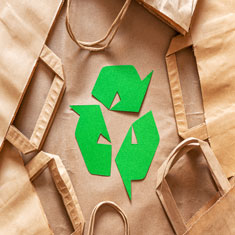Best Eco-Friendly Packaging Materials

What is packaging material?Packaging material helps to protect goods in storage and transit. Some examples of packaging materials include polystyrene, wool, cardboard, paper wrap and plastic, however, with sustainability now a crucial priority for businesses, moving towards more environmentally friendly options is now essential. What is eco-friendly packaging?Eco friendly packaging materials include paper, card, and foam - in short, anything that can be easily recycled or reused. Biodegradable packaging materials and organic packaging materials also fit under this umbrella, such as pulp and bioplastic. Soft plastic packaging such as bubble wrap and plastic fillings is often single-use and not recyclable, which warrants the criticism it is now facing from consumers and businesses alike. Consumers are now thinking with their feet, and sustainable packaging options are one of the key things now considered by customers when making a purchase. Pros and cons of eco-friendly packagingFoam is a great eco-friendly packaging option as it is highly durable and can be custom cut to protect and support any type of products. It is reusable and therefore sustainable, given its strength, its durability and waterproof properties. Closed-cell packaging foam is a great option as it is eco-friendly yet doesn’t compromise on the protection it can offer (unlike paper, which can only protect to a certain extent). At present, some eco-friendly packaging options are not as cost efficient as mass produced plastic packaging that can be manufactured incredibly cheaply. This is a considerable issue given that supply chain costs and profit margins for so many businesses have now been squeezed tighter than ever. However, foam packaging is incredibly cost efficient, making it one of the better environmentally friendly packaging options on the market. The best environmentally friendly packaging materialsThere are a range of environmentally friendly packaging materials now available, meaning that determining which one is ‘best’ is a little trickier than thought. Brands must also look at the manufacturing process of the packaging itself to determine whether it is environmentally friendly. Some may argue that cardboard and paper packaging is only sustainable if sourced from a responsible production line. If not, it can - in some cases - be a contributor to deforestation. Responsibly sourced paper and cardboard solutions are a great choice for packaging, offering support and protection for products. However, foam also offers extensive levels of protection - arguably more so than cardboard. It can be specifically cut to size to ensure a snug fit to a product and is available in various densities to absorb impact and reduce the chase of damage. Likewise, when sourced from a sustainable and ethical manufacturer, foam packaging is also made without the use of harmful chemicals such as Polybrominated diphenyl ethers (PBDEs) or Chlorofluorocarbons (CFCs) which are both harmful for human health and the environment. In short, the best choice out of the three all comes down to personal preference and the items that need to be packaged. That said, there are many other options available including dissolvable packing peanuts, bamboo, cornstarch and organic fabrics. Feel free to contact us to discuss any of your requirements. |



